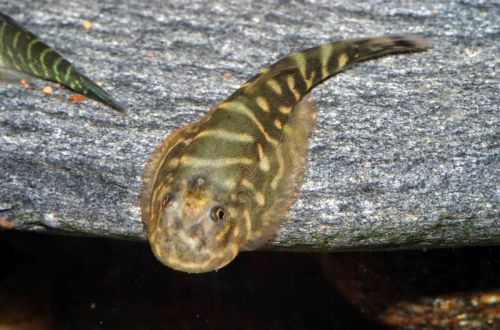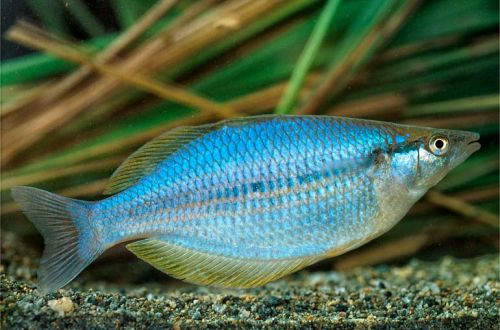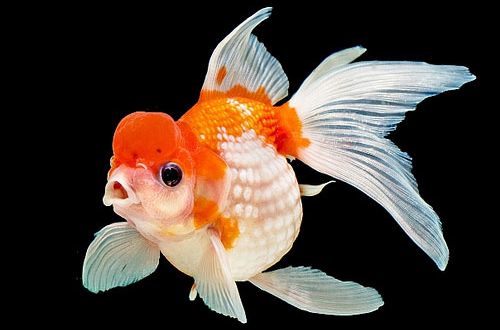
Gastromizon Zebra
Gastromyzon zebra, scientific name Gastromyzon zebrinus, belongs to the Balitoridae family. Unusual appearance, bottom lifestyle, not the brightest colors and the need to create a specific environment – all this significantly reduces the number of people interested in this species of fish. They are distributed mainly among enthusiasts and lovers of gastromisons.

Contents
Habitat
It comes from Southeast Asia, is endemic to the island of Borneo. They inhabit the mountainous sections of rivers in the Indonesian province of West Kalimantan. A typical biotope is a shallow river bed or stream flowing down the mountain slopes. The current is fast, sometimes stormy with numerous rapids, cascades and waterfalls. Substrates usually consist of gravel, rocks, boulders. Aquatic vegetation is represented mainly by coastal plants.
Brief information:
- The volume of the aquarium – from 70 liters.
- Temperature – 20-24°C
- Value pH — 6.0–7.5
- Water hardness – soft to medium hard (2-12 dGH)
- Substrate type — stony
- Lighting – moderate / bright
- Brackish water – no
- Water movement – moderate or strong
- The size of the fish is about 6 cm.
- Nutrition – plant-based sinking food, algae
- Temperament – peaceful
- Content alone or in a group
Description
Adult individuals reach a length of about 6 cm. The fish have a body shape typical of gastromisons – strongly flattened from above, resembling a disk in the front. Large pectoral fins follow the shape of the body, making it even more rounded. A similar disc-shaped structure, coupled with a sucker-like mouth, helps to cope with strong currents. The coloration is dark gray or brownish with yellowish markings, on the back in the form of stripes. A similar striped pattern is reflected in the name of this species – “zebra”. Sexual dimorphism is weakly expressed, it is problematic to distinguish a male from a female.
Food
In nature, they feed on algae growing on the surface of stones and snags, and microorganisms living in them. In the home aquarium, the diet should also consist predominantly of plant foods combined with protein foods. In strong current conditions, the choice of suitable products is limited. The most natural food will be natural algae, the growth of which can be stimulated with bright light. However, there is a danger of their overgrowth. Another suitable type of food is special gel or paste food, usually supplied in tubes. Feed should be placed in different places in the aquarium each time to avoid territorial behavior in these fish.
Maintenance and care, arrangement of the aquarium
The optimal size of the aquarium for a group of 3-4 fish starts from 70 liters. For long-term maintenance of the Zebra Gastromizon, it is important to provide clean water rich in dissolved oxygen and to create a moderate or even strong flow of water to simulate the rapid flow of a mountain stream. One or more (depending on the size of the tank) internal filters will cope with these tasks. It is desirable that the water turnover be 10–15 times per hour, i.e. for an aquarium of 100 liters, a filter is required that can pass through itself from 1000 liters in one hour.
In such a turbulent environment, the choice of design is limited. Do not use light decorative elements. The basis will be stones, pebbles, fragments of rocks, several massive natural snags. The latter, with a high level of illumination, will become a place for the growth of natural algae – an additional source of food. Not all living plants will be able to grow normally in such an environment. It is worth giving preference to varieties that can grow on the surface of snags and withstand a moderate current. For example, anubias, Javanese fern, krinum and others.
Behavior and Compatibility
Calm fish, although it is considered territorial. But this behavior is manifested if the food is dispersed throughout the aquarium. If she is in one place, then peaceful absorption of food will not work. Feels great in the company of relatives and other non-aggressive species of comparable size. However, the number of compatible fish is not large due to the specifics of the habitat. For example, these are other loaches and gastromisons, and with a not so strong current, danios, barbs and other cyprinids will become good neighbors.
Breeding / breeding
Successful cases of breeding in home aquaria have been recorded, but require considerable experience from the aquarist and are unlikely to be realized by a beginner.
Fish diseases
Health problems arise only in case of injuries or when kept in unsuitable conditions, which depresses the immune system and, as a result, provokes the occurrence of any disease. In the event of the appearance of the first symptoms, first of all, it is necessary to check the water for the excess of certain indicators or the presence of dangerous concentrations of toxic substances (nitrites, nitrates, ammonium, etc.). If deviations are found, bring all values back to normal and only then proceed with treatment. Read more about symptoms and treatments in the Aquarium Fish Diseases section.





